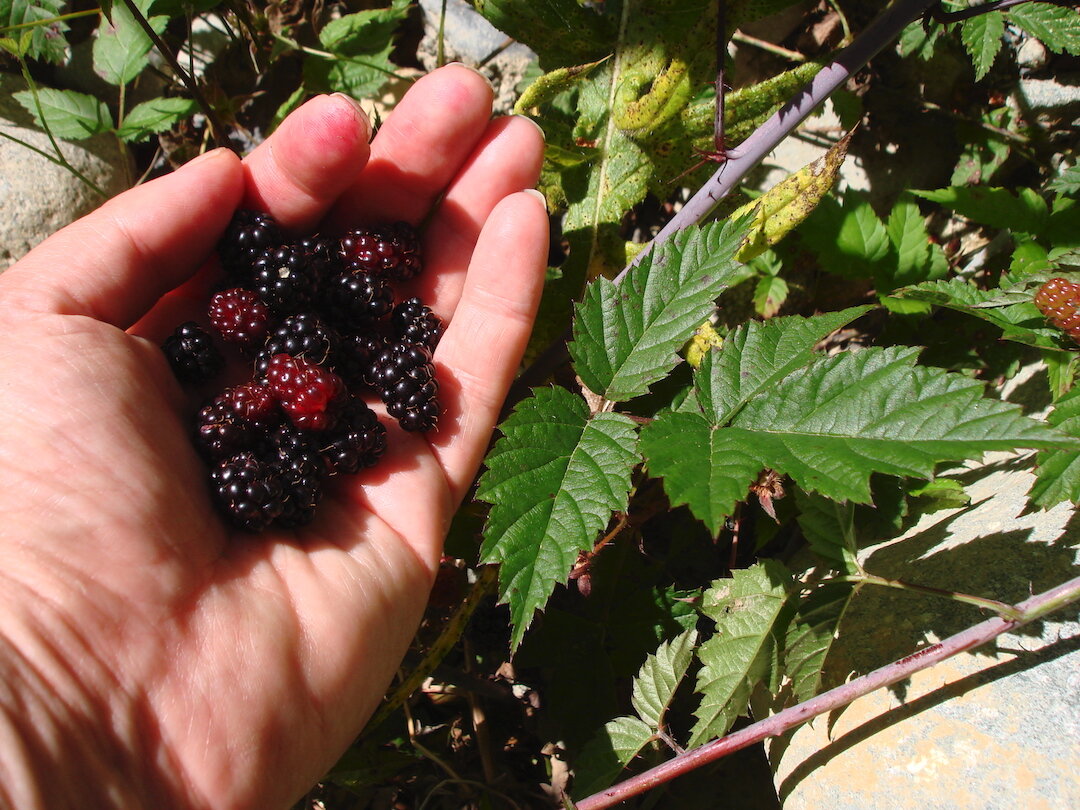Plant of the Month - December
Trailing blackberry, or Trailing dewberry (Rubus ursinus)
Trailing blackberry is our only native blackberry in British Columbia. It is a prickly, trailing woody, vine related to raspberry, salmonberry, blackcap and thimbleberry – all in the genus Rubus. Its stems can grow up to four or five meters long, scrambling over low vegetation, and readily rooting at the tips, allowing the plants to form dense patches. The prickles are fine and sharp, and can easily become embedded into the skin. Its leaves are alternate, pinnately compound and three-parted, or rarely five-parted. The leaflets are coarsely toothed and pointed, the terminal leaflet larger than the lateral leaflets, and often deeply three-lobed. The leaves are deciduous, but often remain on the vines through the winter, sometimes turning deep reddish purple before dropping off.
The flowers of trailing blackberry are borne in clusters on side branches that are more upright than the vegetative vines, up to 50 cm tall. Male flowers (with numerous pollen-bearing stamens) and female flowers are borne on separate plants; both have white corollas, each with five elongated petals and woolly calyxes. The flowers are pollinated by bees – including native bees and bumblebees.
The berries are typical blackberries, elongated, and up to 1.5 cm long, comprised of shiny black drupelets clinging to a fleshy receptacle. They ripen over a period of a few weeks, generally in early July – earlier than the berries of the introduced Himalayan or Armenian blackberry, whose berries are larger and later ripening – usually in late July and August. Many would argue that the native training blackberries are sweeter and more flavourful than the Himalayan and cutleaf blackberries, which are invasive and often more prolific. Trailing blackberries are enjoyed not only by people but by songbirds, deer, bear and other mammals.
Trailing blackberry occurs in Canada only in southwestern British Columbia. It is common on Vancouver Island, the Gulf Islands and the adjacent Mainland, in clearings, thickets, roadsides and open woods from sea level to middle elevations. Its overall range extends east into Idaho and south to northern California. Trailing blackberry is common at Wildwood, growing in open woods and edges of meadows.
Food Use
Trailing wild blackberries are sweet and tasty, one of the most juicy and flavourful of all the wild berries of our region. Indigenous Peoples have long enjoyed these berries as part of their healthy traditional diet. In the past, the berries were harvested by the basketful and eaten fresh, especially by children. The berries were also boiled briefly and dried into cakes, or “fruit leather,” to be eaten like candy, or reconstituted by soaking in water overnight. More recently, the berries are made into jams and jellies or baked into pies, muffins and other confections.
The reddish leaves of this blackberry can also be harvested, dried and used in wild tea mixes. They are also used, sometimes with the rhizomes of licorice fern, to sweeten medicinal teas made from tree barks and other plant materials. People also enjoy introduced and cultivated blackberries, including Himalayan blackberry (Rubus armeniacus), Allegheny blackberry (Rubus allegheniensis), and cutleaf blackberry (Rubus laciniata), all of which have larger, more robust stems.
The Hul’qumi’num (Cowichan and Nanaimo) name for trailing wild blackberry is skw’éyəlməxw and the Straits Salish name is similar: sqw’əlngəxw (both derived from the original Proto-Salish term qw’ay, meaning ‘to scorch or burn; black; ripen’). The Kwakwa’kawakw named it after it’s habit as a vine: dúxwm’es (cf. dúkwalha ‘to stretch out on the ground’). They made a medicine from the vines and roots to treat vomiting and diarrhea.
References:
Klinkenberg, Brian. (Editor) 2019. E-Flora BC: Electronic Atlas of the Plants of British Columbia [eflora.bc.ca]. Lab for Advanced Spatial Analysis, Department of Geography, University of British Columbia, Vancouver.
Turner, Nancy J. 2010. Food Plants of Coastal First Peoples. Victoria: Royal BC Museum.
Turner, Nancy J. and Marcus A.M. Bell. 1973. The ethnobotany of the Southern Kwakiutl Indians of British Columbia. Economic Botany, 27(3), 257-310.
Turner, Nancy J. and Richard Hebda. 2012. Saanich Ethnobotany: Culturally Important Plants of the WSÁNEC’ People. Royal B.C. Museum, Victoria.
Delicious berries!
A mix of ripe and underripe berries makes a perfect mix for jam!
A lovely basket made from trailing blackberry vines




